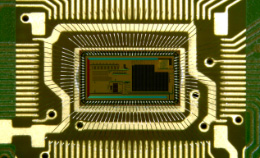PanaMEA – ASIC for a Miniature Pancreatic Implant
Veröffentlicht am

Newsletter 1/2022
PanaMEA - ASIC for a Miniature Pancreatic Implant
Front-end signal processing of Beta-cell electrical activities captured by a Micro-Electrode Array (MEA)

Front-end beta-cell signal processing scheme
There are millions of people worldwide suffering from type 2 diabetes mellitus, which is caused by the body’s ineffective use of insulin. The insulin is generated in the beta-cells in the pancreas. There is a direct relationship between the beta-cell’s electrical activity in the form of membrane oscillatory bursts and extracellular glucose concentration. In the BMBF project “PanaMEA” (Pankreas- Implantat auf MEA-Basis, grant number 13GW0397), a miniaturized pancreatic implant is being developed that measures this electrical activity.
The main task for IMS CHIPS is to develop a low-power front-end ASIC to do signal processing of the beta-cell signals captured by a microelectrode array (MEA). A bio-marker, the so-called Fraction of Plateau Phase (FOPP), is defined for the beta-cell signal. It is the percentage of time with beta-cell activity. A high FOPP corresponds to a high glucose level. In conventional beta-cell monitoring methods, all signal details, including FOPP-irrelevant high frequency contents are recorded, and the FOPP value is calculated by postprocessing this signal. This will lead to a big data volume and results in a system with high-power consumption for data transmission and processing. Instead of recording all the signal details, we have used a very simple circuit structure, i.e., a differential envelope detector with diodes and capacitors, to filter out the high frequency contents and obtain the FOPP-relevant information. The design overhead is kept to a minimum and the data volume is highly reduced. The idea and the effectiveness of the circuits are validated by ASIC measurements. The next steps are to carry out in-vitro measurements and encapsulate the ASIC for implantation experiments.